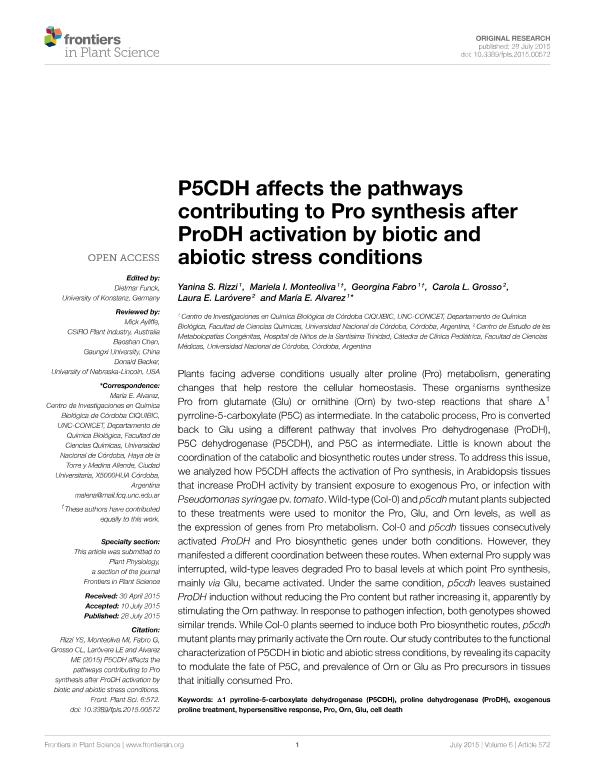Mostrar el registro sencillo del ítem
dc.contributor.author
Rizzi, Yanina

dc.contributor.author
Monteoliva, Mariela Inés

dc.contributor.author
Fabro, Georgina

dc.contributor.author
Grosso, Carola

dc.contributor.author
Laróvere, Laura Elena

dc.contributor.author
Alvarez, Maria Elena

dc.date.available
2018-06-29T17:30:24Z
dc.date.issued
2015-07
dc.identifier.citation
Rizzi, Yanina; Monteoliva, Mariela Inés; Fabro, Georgina; Grosso, Carola; Laróvere, Laura Elena; et al.; P5cdh affects the pathways contributing to pro synthesis after prodh activation by biotic and abiotic stress conditions; Frontiers Research Foundation; Frontiers in Plant Science; 6; JULY; 7-2015; 1-11
dc.identifier.issn
1664-462X
dc.identifier.uri
http://hdl.handle.net/11336/50692
dc.description.abstract
Plants facing adverse conditions usually alter proline (Pro) metabolism, generating changes that help restore the cellular homeostasis. These organisms synthesize Pro from glutamate (Glu) or ornithine (Orn) by two-step reactions that share Δ1 pyrroline-5-carboxylate (P5C) as intermediate. In the catabolic process, Pro is converted back to Glu using a different pathway that involves Pro dehydrogenase (ProDH), P5C dehydrogenase (P5CDH), and P5C as intermediate. Little is known about the coordination of the catabolic and biosynthetic routes under stress. To address this issue, we analyzed how P5CDH affects the activation of Pro synthesis, in Arabidopsis tissues that increase ProDH activity by transient exposure to exogenous Pro, or infection with Pseudomonas syringae pv. tomato. Wild-type (Col-0) andp5cdh mutant plants subjected to these treatments were used to monitor the Pro, Glu, and Orn levels, as well as the expression of genes from Pro metabolism. Col-0 and p5cdh tissues consecutively activated ProDH and Pro biosynthetic genes under both conditions. However, they manifested a different coordination between these routes. When external Pro supply was interrupted, wild-type leaves degraded Pro to basal levels at which point Pro synthesis, mainlyvia Glu, became activated. Under the same condition, p5cdh leaves sustained ProDH induction without reducing the Pro content but rather increasing it, apparently by stimulating the Orn pathway. In response to pathogen infection, both genotypes showed similar trends. While Col-0 plants seemed to induce both Pro biosynthetic routes, p5cdh mutant plants may primarily activate the Orn route. Our study contributes to the functional characterization of P5CDH in biotic and abiotic stress conditions, by revealing its capacity to modulate the fate of P5C, and prevalence of Orn or Glu as Pro precursors in tissues that initially consumed Pro.
dc.format
application/pdf
dc.language.iso
eng
dc.publisher
Frontiers Research Foundation

dc.rights
info:eu-repo/semantics/openAccess
dc.rights.uri
https://creativecommons.org/licenses/by-nc-sa/2.5/ar/
dc.subject
Cell Death
dc.subject
Exogenous Proline Treatment
dc.subject
Glu
dc.subject
Hypersensitive Response
dc.subject
Orn
dc.subject
Pro
dc.subject
Proline Dehydrogenase (Prodh)
dc.subject
Δ1 Pyrroline-5-Carboxylate Dehydrogenase (P5cdh)
dc.subject.classification
Otras Ciencias Biológicas

dc.subject.classification
Ciencias Biológicas

dc.subject.classification
CIENCIAS NATURALES Y EXACTAS

dc.title
P5cdh affects the pathways contributing to pro synthesis after prodh activation by biotic and abiotic stress conditions
dc.type
info:eu-repo/semantics/article
dc.type
info:ar-repo/semantics/artículo
dc.type
info:eu-repo/semantics/publishedVersion
dc.date.updated
2018-06-29T16:44:09Z
dc.journal.volume
6
dc.journal.number
JULY
dc.journal.pagination
1-11
dc.journal.pais
Suiza

dc.journal.ciudad
Lausanne
dc.description.fil
Fil: Rizzi, Yanina. Consejo Nacional de Investigaciones Científicas y Técnicas. Centro Científico Tecnológico Conicet - Córdoba. Centro de Investigaciones en Química Biológica de Córdoba. Universidad Nacional de Córdoba. Facultad de Ciencias Químicas. Centro de Investigaciones en Química Biológica de Córdoba; Argentina
dc.description.fil
Fil: Monteoliva, Mariela Inés. Consejo Nacional de Investigaciones Científicas y Técnicas. Centro Científico Tecnológico Conicet - Córdoba. Centro de Investigaciones en Química Biológica de Córdoba. Universidad Nacional de Córdoba. Facultad de Ciencias Químicas. Centro de Investigaciones en Química Biológica de Córdoba; Argentina
dc.description.fil
Fil: Fabro, Georgina. Consejo Nacional de Investigaciones Científicas y Técnicas. Centro Científico Tecnológico Conicet - Córdoba. Centro de Investigaciones en Química Biológica de Córdoba. Universidad Nacional de Córdoba. Facultad de Ciencias Químicas. Centro de Investigaciones en Química Biológica de Córdoba; Argentina
dc.description.fil
Fil: Grosso, Carola. Universidad Nacional de Cordoba. Facultad de Medicina. Centro de Estudios de las Metabolopatías Congénitas; Argentina
dc.description.fil
Fil: Laróvere, Laura Elena. Universidad Nacional de Cordoba. Facultad de Medicina. Centro de Estudios de las Metabolopatías Congénitas; Argentina. Consejo Nacional de Investigaciones Científicas y Técnicas; Argentina
dc.description.fil
Fil: Alvarez, Maria Elena. Consejo Nacional de Investigaciones Científicas y Técnicas. Centro Científico Tecnológico Conicet - Córdoba. Centro de Investigaciones en Química Biológica de Córdoba. Universidad Nacional de Córdoba. Facultad de Ciencias Químicas. Centro de Investigaciones en Química Biológica de Córdoba; Argentina
dc.journal.title
Frontiers in Plant Science
dc.relation.alternativeid
info:eu-repo/semantics/altIdentifier/doi/http://dx.doi.org/10.3389/fpls.2015.00572
dc.relation.alternativeid
info:eu-repo/semantics/altIdentifier/url/https://www.frontiersin.org/articles/10.3389/fpls.2015.00572/full
Archivos asociados
